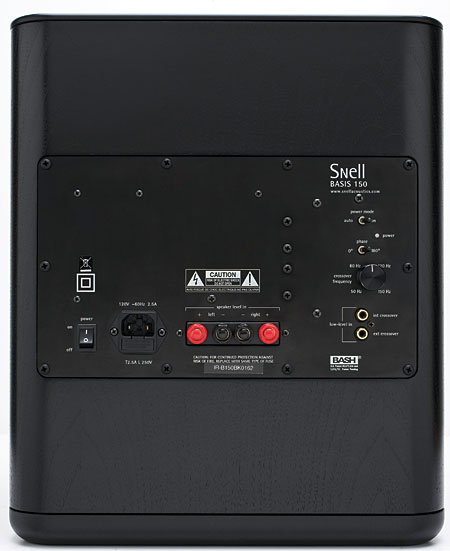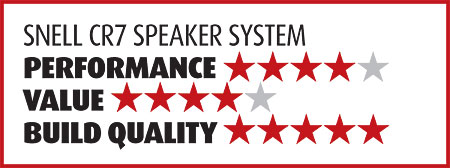Snell CR7 Speaker System Page 2

Associated equipment for this review included the Rotel RSX-1550 A/V receiver, Panasonic DMP-BD35 Blu-ray player, Luxman PD-289 turntable, Shure V97xE cartridge, and Bellari VP530 phono preamp.
Trial by Matrix
My ongoing meditation on the Matrix boxed set continued with The Matrix: Reloaded. Beginning with this was almost an act of cruelty, plunging the Snells into the deep end of the pool before I even knew if they could swim.
The Dolby TrueHD soundtrack has overwhelming dynamic swings. I ended up using about two-thirds of the receiver’s volume control range for dialogue but barely more than half for the delirious flying bullets and smashing glass of the action scenes. Let me emphasize that this was no fault of the speakers. I’d have done the same with any other speakers. The only practical way to solve the problem would be to use one of the new dynamic-range adjustment modes (Dolby Volume, THX Loudness Plus, or Audyssey Dynamic Volume/EQ).
The manufacturer says the speaker can produce “101 dB of continuous output from 12 feet away when used with a 75-watt [per channel] amplifier,” which coincidentally is an accurate description of the Rotel. I believe it. The most pleasing moments came in the score’s frequent use of brass to signal tension, accompany action, or generate wonder. An underground scene with ritual pounding drums demonstrated the sub’s ability to generate tight and tuneful bass. The rest of the movie’s low-frequency effects were deliberately crude. But this is a flaw that’s embodied in the source material—as this and many other subs have demonstrated to me over the years. Call it the Matrix syndrome.
Fargo was a complete change of pace, with its close-miked dialogue and vast silences. Gunshots in open air got a tight reverb treatment. While the CR7’s soundstage wasn’t huge or vertically airy, it was dense, vivid, and controlled. In the orchestral score by Carter Burwell—who has written a lot of my favorite film music—a solo violin or oboe sometimes detaches itself from the orchestra. Celesta peeps through in several scenes, but it took me a while to recognize it. The speakers were dispassionate and true to the source material; they neither hyped nor dumbed down the elements I found attractive. As I moved restlessly around the sofa, I found the front soundstage commendably solid, with no large timbral shifts or drop-off in volume as I moved in and out of the sweet spot. These speakers do a fine job of covering multiple horizontal positions in a room.
Yes Man didn’t default to its Dolby TrueHD soundtrack, unlike many TrueHD Blu-rays I’ve played lately. Jim Carrey vigorously employs his vast gift for physical comedy as a guy who’s given up saying no. Zooey Deschanel is sweetly charismatic as the love interest—when she and Carrey were onscreen together, my eyes were drawn to her. I’ve begun classifying comedy soundtrack mixes as A (with some dynamics, but not abusively wide) and B (mixed for television). This one is an A-list comedy mix, with ferocious indoor crowd scenes and music that punches through with welcome clarity and exuberance. In this movie and the preceding one, the Snells were listenable at the necessary variety of levels, and I found a master volume setting that sufficed for everything.
Tremolo and Vibraharp
The CR7 rocked and rolled with John Mayall’s A Sense of Place CD, a forgotten gem from 1990. The well-balanced drum sound, with good integration between speakers and sub, underpinned the guitar team of Sonny Landreth on slide and Coco Montoya on lead. This became apparent in track one, “I Want to Go,” which segues from an acoustic slide to a full frontal electric assault. It was a good sign that I was able to play it moderately loud. The Dolby Pro Logic II Music mode was especially effective during “Sensitive Kind,” in which Montoya’s tremolo-laced guitar floated hauntingly through the soundfield. Mayall’s occasional piano playing sparkled, and his harmonica (an instrument for which I have a limited appetite) was painless, a tribute to both the mix and the speakers.
Leonard Bernstein Conducts Haydn (to use the Amazon title, since the packaging is a little vague) is a boxed set that chronicles the maestro’s traversals of the London Symphonies, Paris Symphonies, and masses from 1958 to 1975. Sony Classics’ brand-new 12-disc set features the New York Philharmonic on most items and should not be confused with DG’s four-disc set of the same name, from later in Bernstein’s career. Columbia close-miked these recordings for a front-row feeling that dovetailed with the Snells’ tight soundstage. Best suited for listening at low to moderate volumes, the sound was amazingly consistent even as the orchestra moved from the Manhattan Center, to the famed 30th Street Studio, to the acoustically hopeless Philharmonic Hall. However, the speakers immediately adapted from the front-of-the-hall feeling to the gentler middle-of-the-hall feeling of the final disc—the only one with the London Symphony Orchestra, recorded in the acoustically desirable Henry Wood Hall. In this final recording, the “Theresienmesse,” the speakers summoned a gentler and more euphonic sound, with better-defined ambience and more voluptuous texture. I could play it somewhat louder.
The Modern Jazz Quartet at the Music Inn Vol. 1 shows the musically omnivorous group at work with clarinetist Jimmy Giuffre. I played this mono recording, by Tom Dowd, in two channels and marveled at the amount of depth it supported even without stereo or surround. Milt Jackson’s vibraharp undulated at the front along with Percy Heath’s bass. Pianist John Lewis and drummer Connie Kay hung back at the rear, with the clarinet somewhere in between. The string bass was powerful, and the sub delivered it with pitches intact, true to the intention of the performance. My tubed phono preamp can be a little nebulous at the top end, and the Snells accurately conveyed this. But together, they conjured a sweet, ripe midrange that combined with the music’s shimmering eclecticism for a mesmerizing effect.
The Snell CR7 and Basis 150 are not only built here but built well. While the world is full of well-made and sonically versa- tile speakers, not many of them have this small-footprint form factor. If you want to wall-mount a beautifully engineered set of speakers and want better sound than most shallow-depth on-walls are capable of providing, the CR7s may be just the companions your flat-panel display has been crying out for.





























































